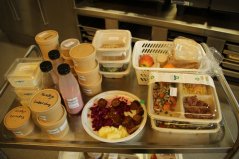
News
Operations Research advances nutrition research
Operations Research models are a great help for nutrition research.
Nutrition research investigates relations between nutrition and health in order to formulate dietary advice that benefits our health, such as “Eat vegetables every day”. One type of research to study this are so-called controlled feeding trials. Controlled feeding trials help to answer research questions such as “What is the effect of protein shortage in the body on food preferences?”.

The division of Human Nutrition and Health has a long history of conducting controlled feeding trials. During several weeks, participants of a controlled feeding trial receive full-day menus (breakfast, lunch, diner, snacks). The participants must consume everything that is provided and nothing more. The menus contain specific foods or nutrients, or a specific dietary pattern. The menus differ between participants of the trial, so that nutrition researchers can study the effect of the specific menus. Designing the menus is both a nutritional and a computational challenge, and very time-consuming. Until recently, the menus were composed with no other help than a nutrient calculation program, a spreadsheet application, and lots of experience. An impressive achievement!
In close cooperation between the ORL group and the division of Human Nutrition and Health, a mathematical model was developed for the design of menus for controlled feeding trials. With the model, menus can be designed in only a fraction of the time that was needed in the past. Moreover, the model helps to answer what-if questions such as “What if we adjust our menu to the preferences of vegetarian volunteers; can protein levels remain the same?” It also helps to handle last-minute disruptions, such as “Our supplier changed the composition of the salad. How to deal with that?” The model is flexible, reduces the workload of nutrition researchers, and lowers the development costs.
The research described here is an example of the exciting advances that can be made through collaborations between nutritionists and mathematical modellers (Holscher, 2023).
More details on the study can be found in the full paper available on the publisher's website:
Gerdessen, J. C. and K. J. Borgonjen-van den Berg (2023). "A linear programming based method for designing menus for controlled feeding trials." The American Journal of Clinical Nutrition 117(2): 408-413. https://doi.org/10.1016/j.ajcnut.2022.11.006
Holscher, H. D. (2023). "Let's do the math: embracing mathematical modeling to advance nutrition research." The American Journal of Clinical Nutrition 117(2): 220-221. https://doi.org/10.1016/j.ajcnut.2022.12.011
Examples of controlled feeding trials can be found in:
Griffioen-Roose, S., M. Mars, E. Siebelink, G. Finlayson, D. Tomé and C. De Graaf (2012). "Protein status elicits compensatory changes in food intake and food preferences." American Journal of Clinical Nutrition 95(1): 32-38. https://doi.org/10.3945/ajcn.111.020503
Backx, E. M. P., M. Tieland, K. J. Borgonjen-Van Den Berg, P. R. Claessen, L. J. C. Van Loon and L. C. P. G. M. De Groot (2016). "Protein intake and lean body mass preservation during energy intake restriction in overweight older adults." International Journal of Obesity 40(2): 299-304. https://doi.org/10.1038/ijo.2015.182